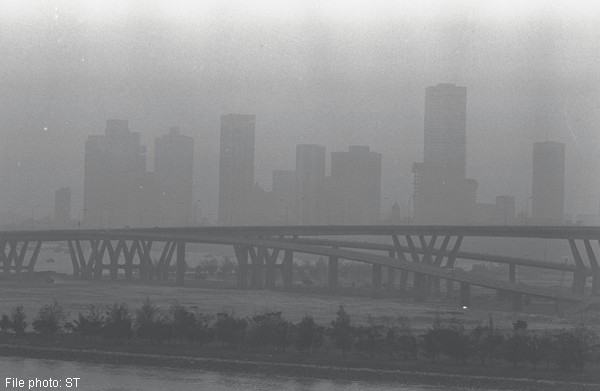New unit to study threats like volcanic ash, radioactive fallout

A new unit within the Meteorological Service Singapore is studying the risk of not just known threats such as haze but also of lesser-known ones such as volcanic ash, radioactive fallout, tsunamis, storm surges and even particles from outer space.
The Hazard Risk and Impact Assessment Unit was set up last year partly to better understand emerging hazards that, though relatively rare, could affect Singapore.
For instance, sudden releases of energy from the sun called solar flares have been known to eject clouds of particles travelling at high speed that bombard the earth within a day or two.
These could disrupt satellites and power grids. They could also affect the transmission of radio waves, which commercial planes rely on for communication.
"Every threat that we have ever faced has started out as not very important," said unit deputy director Felicia Shaw.
For example, storm surges - rising seawater caused by tropical cyclones - have been more prevalent in the region than here. But Dr Shaw noted that Singapore is surrounded by the sea and has experienced minor surges before.
Ash from nearby volcanic eruptions could also reach the Republic. Sensors will be installed by year-end to determine more quickly if, and how, this would happen.
There is also the threat of radioactive fallout from accidents at nuclear plants. Neighbouring Malaysia, Indonesia and Vietnam have shown interest in nuclear energy.
"We need to study (all these hazards) and assure ourselves that we are prepared," said Dr Shaw.
The new unit is also developing tools to analyse the haze better. It plans to install aerosol and wind lidars by this year. These use lasers and radar to collect data on particles in the atmosphere and wind speeds and direction.
Meanwhile, researchers from the Meteorological Service's Centre for Climate Research Singapore have worked out why Singapore had a record dry spell this February - and are trying to pin down if it will happen again.
The dry spell, when rainfall was 45 per cent to 100 per cent below the month's long-term average, was due to cool dry air sinking over the Malaysian peninsula as warm damp air rose further east. At the time, Singapore was in the dry phase of the Madden- Julian oscillation, an eastward procession of varying wet and dry weather that cycles over the tropics every 30 to 60 days.
As the long dry spell was such a rarity, and that combination of conditions had not been seen since 1948, the centre's researchers are trying to simulate those conditions with computer models.
The centre is refining its climate and weather prediction models but it will be "a year or two" before these can be used for precise forecasts.
Said its director Chris Gordon: "We're trying to answer the question, what are the causes of extremes in the region, both wet and dry? If we in this region don't study this region, nobody's going to."
davidee@sph.com.sg
caiwj@sph.com.sg

This article was first published on June 24, 2014.
Get a copy of The Straits Times or go to straitstimes.com for more stories.